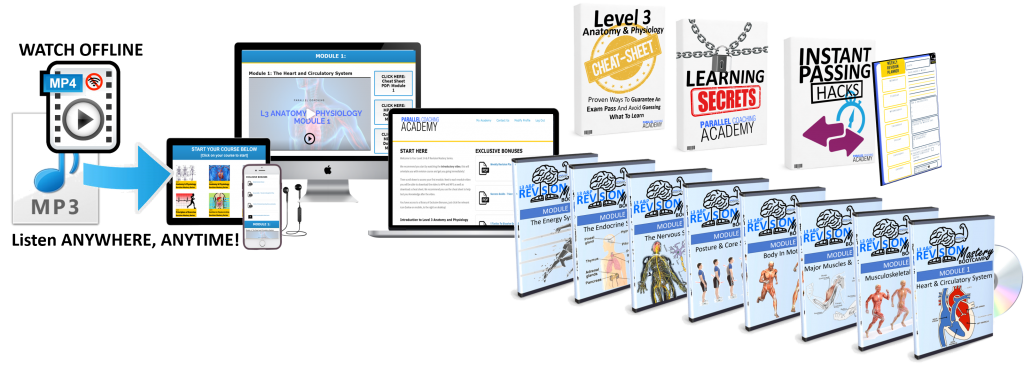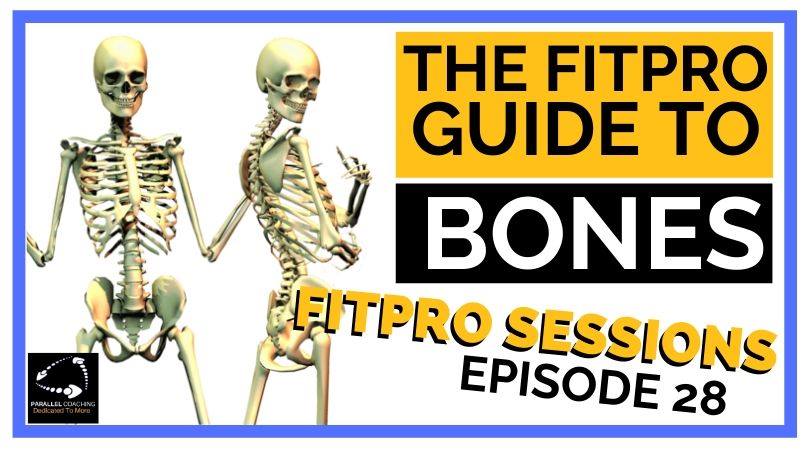Today’s FitPro Sessions Podcast is the FitPro Guide To Bones.
FitPros often see the SKELETON as something that they need to know just for the anatomy exam;
this means that as soon as your exam is over
poof!
All the information disappears from your brain
The biggest problem with this is that forgetting the info learned about the BONES effects your ability to be an outstanding coach
It’s a cascade effect:
Without knowing the bones of the body, it is tricky to learn the origin and insertions of muscles.
If you don’t know the origin and insertion of muscles then its hard to understand muscle actions,
If you don’t know muscle actions then you don’t know which muscles worked on exercises.
If you don’t know about muscles worked on exercises then your planning for sessions is GUESSING
Today, Neale and I explore the FitPros guide to Bones, everything you need to know about bones and the skeletal system… with a bit of extra chat about Honeycomb icecream 🙂
Click the PLAY button below to listen to the entire episode
Grab the FitPro Sessions Podcast show notes:
Timestamps:
0:30 Introduction to Episode 028 of the FitPro Sessions Podcast
1:30 Why knowing the bones is important for you as a FitPro beyond the exam
4:00 The cascade effect of not knowing the bones
6:30 Physiological adaptation, posture and technique
8:30 The Skeletal System overview and functions
14:00 The bones you need to know for your fitness exam
15:50 The 5 types of bones in the body
23:30 Understanding the different layers of bone tissue
26:30 Bone Cells, remodeling of bone tissue
29:40 Bone density and preventing osteoporosis
35:30 Why anatomy and knowing the bones is important
36:30 Your invitation to our Revision Mastery Bootcamps
38:40 Reach out to us and join us in our Inner circle Facebook Group
The FitPros Guide To Bones:
By learning the Skeletal system and valuing this knowledge it will advance you as a FitPro and as a coach.
For example, knowing the bones and skeletal system allows you to KNOW exactly WHAT the body should look like when observing your client.
making you a human x-ray machine
Learning the bones and joints allows you to understand movement, injuries, muscle actions and how this relates across to energy systems.
So, although Bones may seem like a tedious link to coaching and instructing clients, this knowledge can impact you greatly.
Skeletal System Facts:
Bones provide the structure and shape to our bodies.
The adult human skeleton is made up of 206 bones.
Bones are made of connective tissue reinforced with calcium and specialised bone cells.
Most bones also contain bone marrow, where blood cells are made.
Bones work with muscles and joints to hold our body together and allow for movement. This is called the musculoskeletal system.
The skeleton also protects delicate internal organs such as the brain, heart and lungs.
Bones contain most of our body’s calcium supply.
The body is constantly building up and breaking down bone tissue as required.
Bones you need to know for the Level 2 and 3 Anatomy Exam
The human skeleton is made up of 206 bones, including bones of the:
- Skull – including the jaw bone
- Spine – cervical, thoracic and lumbar vertebrae, sacrum and coccyx
- Chest – ribs and breastbone (sternum)
- Arms – shoulder blade (scapula), collar bone (clavicle), humerus, radius and ulna
- Hands – wrist bones (carpals), metacarpals and phalanges
- Pelvis – hip bones – ilium, ischium and pubis (3 bones each side)
- Legs – thigh bone (femur), kneecap (patella), shin bone (tibia) and fibula
- Feet – tarsals, metatarsals and phalanges.
Bone types
There are five different types of bone in the human body:
- Long bone – has a long, thin shape. Examples include the bones of the arms and legs. With the help of muscles, long bones work as levers to permit movement.
- Short bone – has a square/ cubed shape. Examples include the bones that make up the hand (carpals) and the foot (tarsals).
- Flat bone – has a flattened, broad surface. Examples include ribs, scapula, sternum and skull bones. The flat shape allows for lots of muscle attachment points.
- Irregular bone – has a shape that does not conform to the above three types. Examples include the bones of the spine (vertebrae).
- Sesamoid bone – is a small bone embedded within a tendon, for example, the kneecap (patella). Other examples are found in the hands and feet.
Bone tissue layers
There are many different layers of bone tissue. Here are the key 4 layers you need to know about:
- Periosteum – the dense, tough outer shell that contains blood vessels and nerves
- Compact or dense tissue – the hard, smooth layer that protects the tissue within
- Spongy or cancellous tissue – the porous, honeycombed material found inside most bones, which allows the bone to be strong yet lightweight
- Bone marrow – the jelly-like substance found inside the cavities of some bones (including the pelvis) that produces blood cells.
Read more about the structure of the Long Bone here:
The Bone cells
Our body is constantly remodeling its skeleton by building up and breaking down bone tissue as required. As a result, each bone is rebuilt from scratch about every decade.
The bone cells involved in this process include:
- Osteoblasts – the cells that build bone tissue
B = Blasts; B = Build - Osteoclasts – the cells that break down old bone tissue.
C = Clasts; C = Collapse - Osteocytes – the cells that maintain bone tissue by controlling the mineral and calcium content
Bone density
Many factors work together to ensure the strength and health of bones. Bone density relies on:
- A steady supply of dietary calcium
- Adequate vitamin D from sunshine and food
- A healthy diet with plenty of vitamins and minerals
- Various hormones including parathyroid hormone, growth hormone, calcitonin, estrogen and testosterone
- Regular weight-bearing exercise.
Find out more about osteoporosis and bone density here:
https://parallelcoaching.co.uk/what-is-osteoporosis-and-what-exercises-are-best
Guide To Bones Mock Questions:
Q1. What is the name given to the bone cells that build new bone?
A. Osteoclasts
B. Osteoblasts
C. Osteocytes
D. Osteoporosis
Q2. Which type of bone are the tarsal bones?
A. Long Bone
B. Sesamoid Bone
C. Short Bone
D. Irregular Bone
Q3. What is the name given to the hard outer shell of the bone?
A. Perimysium
B. Epiosteum
C. Periosteum
D. Cancellous bone
Download More Mock Questions like this:
https://revision.parallelcoaching.co.uk/fitness-exam-mock-questions

ANSWERS:
Q1: B
Q2: C
Q3: C
Join our Parallel Coaching Inner Circle with other FitPros like you
https://www.facebook.com/groups/parallelcoachinginnercircle/
Need More Help with your Fitness Learning and Exam Revision?
Discover How 6500+ Fitpros In Training Are Walking Into Their Exam With Confidence And Guaranteeing A Pass
Are you tired of staring at your manual and not knowing where to start?
Our revision mastery bootcamp breaks everything down into a clear and easy to follow structure.
You can then download the videos to MP3 and MP4 to slice your revision time in half and finally understand the key principles of exercise.
This is not another course with more exams – it HELPS pass the course you’re already enrolled on!
“EVERYTHING You Need To Learn, Revise And Pass Your Fitness Exam”
If you want to get your revision structured, learn everything you need to know and feel confident on exam day, then click the link below:
https://revision.parallelcoaching.co.uk/fitness-exam-revision-courses

Dedicated to More
Hayley “guide to bones” Bergman
Parallel Coaching
P.S. You can also find us on the following platforms:
Instagram: https://www.instagram.com/parallelcoaching
Facebook: https://www.facebook.com/ParallelCoaching
Twitter: https://twitter.com/ParallelCoach
YouTube: http://bit.ly/2F1Z1bs
Download all FitPro Session Shownotes: HERE

